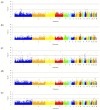Genome-Wide Association Studies and Candidate Genes for Egg Production Traits in Layers from an F2 Crossbred Population Produced Using Two Divergently Selected Chicken Breeds, Russian White and Cornish White
- PMID: 40428405
- PMCID: PMC12111742
- DOI: 10.3390/genes16050583
Genome-Wide Association Studies and Candidate Genes for Egg Production Traits in Layers from an F2 Crossbred Population Produced Using Two Divergently Selected Chicken Breeds, Russian White and Cornish White
Abstract
Background/Objectives: Finding single nucleotide polymorphisms (SNPs) and candidate genes that influence the expression of key traits is essential for genomic selection and helps improve the efficiency of poultry production. Here, we aimed to conduct a genome-wide association study (GWAS) for egg production traits in an F2 resource population of chickens (Gallus gallus). Methods: The examined F2 population was produced by crossing two divergently selected breeds with contrasting phenotypes for egg performance traits, namely Russian White (of higher egg production) and Cornish White (of lower egg production). Sampled birds (n = 142) were genotyped using the Illumina Chicken 60K SNP iSelect BeadChip. Results: In the course of the GWAS analysis, we were able to clarify significant associations with phenotypic traits of interest and economic value by using 47,432 SNPs after the genotype dataset was filtered. At the threshold p < 1.06 × 10-6, we found 23 prioritized candidate genes (PCGs) associated with egg weight at the age of 42-52 weeks (FGF14, GCK), duration of egg laying (CNTN4), egg laying cycle (SAMD12) and egg laying interval (PHF5A, AKR1B1, CALD1, ATP7B, PIK3R4, PTK2, PRKCE, FAT1, PCM1, CC2D2A, BMS1, SEMA6D, CDH13, SLIT3, ATP10B, ISCU, LRRC75A, LETM2, ANKRD24). Moreover, two SNPs were co-localized within the FGF14 gene. Conclusions: Based on our GWAS findings, the revealed SNPs and candidate genes can be used as genetic markers for egg weight and other performance characteristics in chickens to attain genetic enhancement in production and for further genomic selection.
Keywords: candidate genes; chicken (Gallus gallus); egg performance; genome-wide association study (GWAS); single nucleotide polymorphisms (SNPs).
Conflict of interest statement
The authors declare no conflicts of interest. The funders had no role in the design of the study; in the collection, analyses, or interpretation of data; in the writing of the manuscript; or in the decision to publish the results.
Figures




Similar articles
-
Genome-Wide Association Study Reveals the Genetic Architecture of Growth and Meat Production Traits in a Chicken F2 Resource Population.Genes (Basel). 2024 Sep 25;15(10):1246. doi: 10.3390/genes15101246. Genes (Basel). 2024. PMID: 39457370 Free PMC article.
-
Novel Polymorphisms in RAPGEF6 Gene Associated with Egg-Laying Rate in Chinese Jing Hong Chicken using Genome-Wide SNP Scan.Genes (Basel). 2019 May 20;10(5):384. doi: 10.3390/genes10050384. Genes (Basel). 2019. PMID: 31137587 Free PMC article.
-
Genome-wide association analysis of egg production performance in chickens across the whole laying period.BMC Genet. 2019 Aug 14;20(1):67. doi: 10.1186/s12863-019-0771-7. BMC Genet. 2019. PMID: 31412760 Free PMC article.
-
The study of candidate genes in the improvement of egg production in ducks - a review.Poult Sci. 2022 Jul;101(7):101850. doi: 10.1016/j.psj.2022.101850. Epub 2022 Mar 11. Poult Sci. 2022. PMID: 35544958 Free PMC article. Review.
-
Reproduction and production performance of improved chickens, their production constraints, and opportunities under Ethiopian conditions.Trop Anim Health Prod. 2023 Jun 20;55(4):245. doi: 10.1007/s11250-023-03653-w. Trop Anim Health Prod. 2023. PMID: 37340246 Review.
References
-
- Meuwissen T., Hayes B., MacLeod I., Goddard M. Identification of genomic variants causing variation in quantitative traits: A review. Agriculture. 2022;12:1713. doi: 10.3390/agriculture12101713. - DOI
-
- Plemyashov K.V., Smaragdov M.G., Romanov M.N. Molecular Genetic Technologies for Analysis of Gene Expression Related to Animal Productivity and Disease Resistance, Proceedings of the Materials of the 3rd International Scientific and Practical Conference, Moscow, Russia, 30 September 2021. Sel’skokhozyaistvennye Tekhnologii; Moscow, Russia: 2021. Molekulyarno-geneticheskiy polimorfizm v populyatsiyakh zhivotnykh i yego primeneniye v intensivnoy selektsii molochnogo skota: Obzor [Molecular Genetic Polymorphism in Animal Populations and Its Application in Intensive Breeding of Dairy Cattle—A Review] pp. 368–378. (In Russian with English summary)
-
- Plemyashov K.V., Smaragdov M.G., Romanov M.N. Genomnaya otsenka plemennykh bykov [Genomic Assessment of Breeding Bulls] In: Pozyabin S.V., Kochish I.I., Romanov M.N., editors. Molecular Genetic Technologies for Analysis of Gene Expression Related to Animal Productivity and Disease Resistance, Proceedings of the Materials of the 3rd International Scientific and Practical Conference, Moscow, Russia, 30 September 2021. Sel’skokhozyaistvennye Tekhnologii; Moscow, Russia: 2021. [(accessed on 21 April 2025)]. pp. 363–367. Available online: https://elib.spbstu.ru/dl/2/z21-43.pdf/info.
MeSH terms
Grants and funding
LinkOut - more resources
Full Text Sources
Research Materials
Miscellaneous

